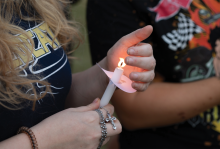Columbine

I WAS ANGRY that this happened again. I was hurting for Apalachee, and for students and school [employees] around our county. I was heartbroken as stories from people in my church close to this tragedy began to come in. I was rattled and processing. I still am.
I was in middle school when Columbine happened. It changed the way I looked at school forever. Then on Wednesday [Sept. 4] my youngest, at 3 years old, experienced her first lockdown. I am thankful to our preschool and church staff for keeping our preschoolers safe, but life shouldn’t be this way. This is the 416th school shooting in our country since Columbine. When will things change?

With each new instance of gun violence, creation cries out with the victims. Creation also helps us center ourselves in relation to God when God feels absent.

Thousands of students across the United States will mark the 19th anniversary of the massacre at Columbine High School by walking out of classes on Friday, in a show of unity intended to put pressure on politicians to enact tighter gun restrictions.

Michael Brown. Sandy Hook. Trayvon Martin. Aurora. Columbine.
Within the last decade, the narrative of children and teenagers being killed by gun violence has become an all-too-familiar narrative in the American public sphere. In a recent report compiled by The Brady Campaign, statistics revealed that in 2011 alone, 19,403 children were shot and 2,703 children and teenagers lost their lives to guns.
That’s seven of America’s youth under the age of 20 killed every day.
In the book of Matthew, the disciples ask Jesus, “Who is the greatest in the kingdom of heaven?”
Jesus calls a child to join the group.
“Truly I tell you, unless you change and become like children, you will never enter the kingdom of heaven,” he answers.
If as Christians, children represent God’s creation in its most pure and innocent form, why is it that as Americans, we continue to let children die preventable deaths from gun violence? Gun control policies are a difficult discourse for the American public. Yet one thing we can all agree on is that children should not be killed.
Of the 2,703 children killed in 2011, 61 percent were homicides, 32 percent were suicides and 5 percent were unintentional shooting. These statistics propel gun-related deaths to the number two leading cause of death for youth in America.

Like many others, I was shocked to hear this morning about the mass killing in an Aurora, Colo., movie theater at the hands of (according to law enforcement authorities) suspect James Eagan Holmes — a 24-year-old California native and neurosciences graduate student at the Univeristy of Colorado in Denver.
Having recently moved from Colorado to Oregon, the Aurora shootings tapped into old feelings as I recalled the Columbine High School killings in 1999. My wife, Amy, was a youth minister at the time, and one of the girls who had previously been a part of her group had helped the Columbine killers buy their guns.
Then there was the attack at New Life Church in Colorado Springs. And now this.
It got me thinking about what all of the killers have in common, and for that matter, what they seem to have in common with many of the mass murderers at the focus of such tragic stories.